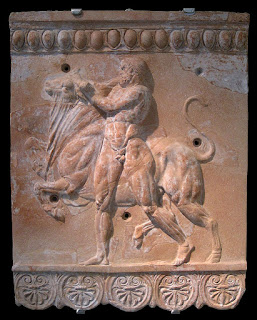According to Jeremy McInerney, the iconography of the bull permeates Minoan culture. The cult of the bull was also prominent in southwestern Anatolia. Bernard Clive Dietrich notes that the most important animal in the Neolithic shrines at Çatalhöyük was the bull. The bull was a chthonic animal associated with fertility and vegetation. It figured in cave cults connected with rites for the dead.
According to Greek myth, to confirm his right to rule, King Minos of Crete prayed to Poseidon to send him a snow-white bull as a sign. Poseidon sent Minos the bull, with the understanding that bull would be sacrificed to the god. Deciding that Poseidon's bull was too fine of a specimen to kill, Minos sent the bull to his herds and substituted another, inferior bull for sacrifice. Enraged, Poseidon had Aphrodite cause Pasiphaë, wife of Minos, to fall in love with the bull. She subsequently gave birth to the half-man, half-bull, Minotaur. Poseidon passed on his rage to the bull, causing him lay waste to the land.
As his seventh labor, Heracles was sent to capture the bull by Eurystheus. Heracles sailed to Crete and King Minos gave Heracles permission to take the bull away as he had been wreaking havoc on Crete by uprooting crops and leveling orchard walls. Heracles captured the bull, and then shipped him to Eurystheus in Tiryns. The bull later broke loose and wandered into Marathon, becoming known as the "Marathonian Bull" who was later captured and sacrificed by Theseus.
McInerney observes that the story of Pasiphaë and the Cretan Bull was not written until after Crete had come under Greek control, however, and despite the fact that the palace at Knossos displays a number of murals depicting young men and women vaulting over a bull, scholars are divided as to whether or not this reflects an actual practice. There is also no recorded evidence that has been recovered there of any Minoan legend of the famous Cretan Bull or the Minotaur either.
 |
| Hercules and the Cretan Bull at Schwerin Castle, Germany courtesy of Wikimedia Commons contributor Jens Burkhardt-Plückhahn |
 |
| Ivory figure of Hercules capturing the Cretan bull, probably used to decorate a piece of furniture or a box, Roman 1st century CE, ivory, courtesy of the British Museum |
 |
| Heracles and the Cretan Bull - a metope from the Temple of Zeus at Olympia, in the Archaeological Museum of Olympia, Greece courtesy of Wikimedia Commons contributor Nicholas Hartmann |
 |
| Detail of a Roman sarcophagus from Perge, Turkey depicting the capture of the Cretan Bull, 2nd century CE (?) courtesy of Wikimedia Commons contributor Mourad Ben Abdallah |




No comments:
Post a Comment